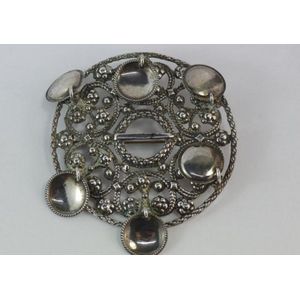Antique Sterling Silver Vesta Cases and Flask Set
Three Victorian and Edwardian sterling silver vesta cases, 1896, 1912 Birmingham, 1907 Chester, with makers' marks for probably Thomas Acott & Co., Horton & Allday, Wj Myatt & Co., a circular target shaped vesta and a rectangular vesta both with a hammered finish and round vacant cartouches, and a flask shaped vesta, the upper register with a lizard skin finish, hallmarked to all, silver weight 92gr
You must be a subscriber, and be logged in to view price and dealer details.
Subscribe Now to view actual auction price for this item
When you subscribe, you have the option of setting the currency in which to display prices to $Au, $US, $NZ or Stg.
This item has been sold, and the description, image and price are for reference purposes only.
- Edwardian - The Edwardian period of English furniture and decorative arts design is named for Edward VII (1841 ? 1910) who was King of the United Kingdom and the British Dominions and Emperor of India for the brief period from 1901 until his death in 1910. It follows the Victorian period, in turn was followed by the Art Nouveau and Art Deco styles. In Australia, designs of this period are also known as being in the Federation style.
- Hammered - A hammered finish on metal wares is achieved by striking the surface of the metal with a hammer to create a series of small, uniform indentations. The indentations can be made in a variety of patterns and depths. The resulting surface texture can vary from a subtle, almost imperceptible texture to a highly textured surface with a strong, pronounced pattern.
The hammered finish adds texture and visual interest to metal objects such as bowls, vases, and other decorative items. It can also be used to add grip or reduce glare on tools, weapons, and other functional metal objects.
A hammered finish can be applied to a range of metals, including copper, brass, silver, and gold. - Victorian Period - The Victorian period of furniture and decorative arts design covers the reign of Queen Victoria from 1837 to 1901. There was not one dominant style of furniture in the Victorian period. Designers used and modified many historical styles such as Gothic, Tudor, Elizabethan, English Rococo, Neoclassical and others, although use of some styles, such as English Rococo and Gothic tended to dominate the furniture manufacture of the period.
The Victorian period was preceded by the Regency and William IV periods, and followed by the Edwardian period, named for Edward VII (1841 ? 1910) who was King of the United Kingdom and the British Dominions and Emperor of India for the brief period from 1901 until his death in 1910. - Sterling Silver - Sterling silver is a mixture of 92.5% pure silver and 7.5% of another metal, usually copper. Fine silver is 99.9% pure silver, and is relatively soft and the addition of the very small amount of copper gives the metal enough strength and hardness to be worked into jewellery, decorative and household objects.
This item has been included into following indexes:
Visually similar items

Three antique sterling silver rose cut diamond 19th century buckles
Sold by
in
for
You can display prices in $Au, $US, $NZ or Stg.

Antique 18ct gold & diamond Rolex wristwatch with white gold mesh band.
Sold by
in
for
You can display prices in $Au, $US, $NZ or Stg.

Norwegian silver brooch 830, used as part of National costume
Sold by
in
for
You can display prices in $Au, $US, $NZ or Stg.

Rare the 'Martin' Tennis Belt C1900 with Brass and Gilt Metal Buckle Fitments Showing Crossed Rackets and Balls and Laurel Wreath, and Original Brass and Thread Expanding Belt.
Sold by
in
for
You can display prices in $Au, $US, $NZ or Stg.
